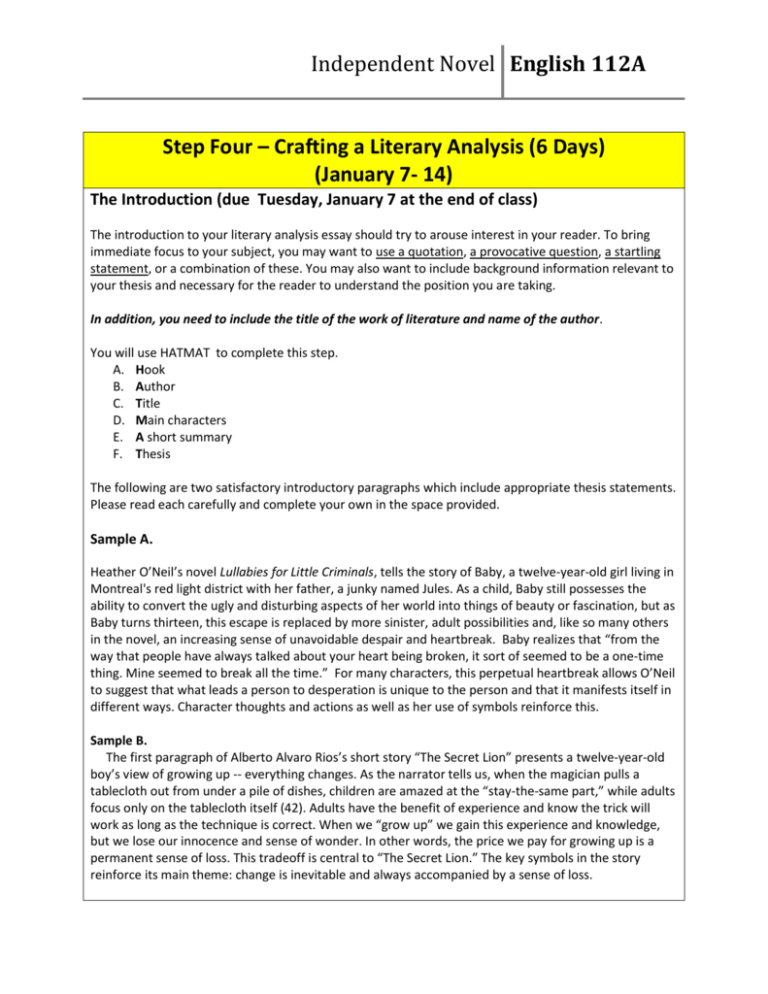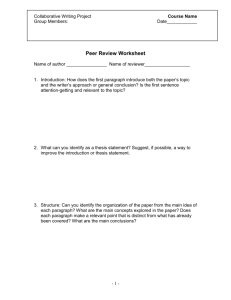Independent Novel
advertisement

Independent Novel English 112A Step Four – Crafting a Literary Analysis (6 Days) (January 7- 14) The Introduction (due Tuesday, January 7 at the end of class) The introduction to your literary analysis essay should try to arouse interest in your reader. To bring immediate focus to your subject, you may want to use a quotation, a provocative question, a startling statement, or a combination of these. You may also want to include background information relevant to your thesis and necessary for the reader to understand the position you are taking. In addition, you need to include the title of the work of literature and name of the author. You will use HATMAT to complete this step. A. Hook B. Author C. Title D. Main characters E. A short summary F. Thesis The following are two satisfactory introductory paragraphs which include appropriate thesis statements. Please read each carefully and complete your own in the space provided. Sample A. Heather O’Neil’s novel Lullabies for Little Criminals, tells the story of Baby, a twelve-year-old girl living in Montreal's red light district with her father, a junky named Jules. As a child, Baby still possesses the ability to convert the ugly and disturbing aspects of her world into things of beauty or fascination, but as Baby turns thirteen, this escape is replaced by more sinister, adult possibilities and, like so many others in the novel, an increasing sense of unavoidable despair and heartbreak. Baby realizes that “from the way that people have always talked about your heart being broken, it sort of seemed to be a one-time thing. Mine seemed to break all the time.” For many characters, this perpetual heartbreak allows O’Neil to suggest that what leads a person to desperation is unique to the person and that it manifests itself in different ways. Character thoughts and actions as well as her use of symbols reinforce this. Sample B. The first paragraph of Alberto Alvaro Rios’s short story “The Secret Lion” presents a twelve-year-old boy’s view of growing up -- everything changes. As the narrator tells us, when the magician pulls a tablecloth out from under a pile of dishes, children are amazed at the “stay-the-same part,” while adults focus only on the tablecloth itself (42). Adults have the benefit of experience and know the trick will work as long as the technique is correct. When we “grow up” we gain this experience and knowledge, but we lose our innocence and sense of wonder. In other words, the price we pay for growing up is a permanent sense of loss. This tradeoff is central to “The Secret Lion.” The key symbols in the story reinforce its main theme: change is inevitable and always accompanied by a sense of loss. Independent Novel English 112A Introductory Paragraph ______________________________________________________________________________ ______________________________________________________________________________ ______________________________________________________________________________ ______________________________________________________________________________ ______________________________________________________________________________ ______________________________________________________________________________ ______________________________________________________________________________ ______________________________________________________________________________ ______________________________________________________________________________ ______________________________________________________________________________ ______________________________________________________________________________ ______________________________________________________________________________ ______________________________________________________________________________ ______________________________________________________________________________ ______________________________________________________________________________ ______________________________________________________________________________ ______________________________________________________________________________ ______________________________________________________________________________ ______________________________________________________________________________ Independent Novel English 112A The Body (due Friday, January 10 at the end of class) At this point, you will use the netbooks to craft your literary analysis. Please begin by typing your introductory paragraph and build from this (see below). You are to use Ariel size 12 font and you will double space the essay. Once completed, save the analysis in your English 112 folder in your “u” drive and name it “Literary Analysis.” The typed introduction and body is to be submitted via edmodo by the end of class on Friday. Those who meet this deadline will benefit from conferencing with me regarding this paper. Those who do not meet this deadline will not have this advantage. Judge your time wisely. How to organize your BODY. Paragraph 2: First Body Paragraph (TCQAC) A. Topic sentence (what this paragraph will discuss [i.e., scene, quotes, biographical info, etc.], how it will prove your thesis) B. Context for the quote or scene 1. Who says it? 2. What’s happening in the text when they say it? C. Quote from the text (cited appropriately) D. Analysis of the quote: How does it prove your thesis? Offer an interpretive commentary on the scene or quotation and make the connection between it and your thesis clear! Explain connections and associations between things both literal and figurative in the text. E. Closing sentence (wrap up the paragraph to effectively transition to the next paragraph) REPEAT III 3-5 TIMES. Repeat this pattern more or less consistently throughout the body of your analysis paper. Do no merely chop into quotations and assume they stand for themselves. Make the connection between your thesis and evidence clear, either implicitly or explicitly. Note: A sample will be provided in class. Independent Novel English 112A The Conclusion (due Monday, January 13 at the end of class) Your typed conclusion will be added to the rest of your paper. Conclusion (You do not necessarily have to follow this order, but include the following): A. Briefly summarize the main points you have tried to emphasize throughout you discussion. B. Clarify the “larger meaning” of the text—this is a good place to say what the text reveals abut some aspect of human nature. C. Comment on what the text made you see—either for the first time, or in a new way. Finishing Touches (Tuesday, January 14 & Wednesday, January 15) Austin’s Butterfly (in-depth critique) Formatting (Owl Purdue) The completed paper will be submitted via edmodo by the end of the day on Wednesday, January 15. Rubric is attached.



